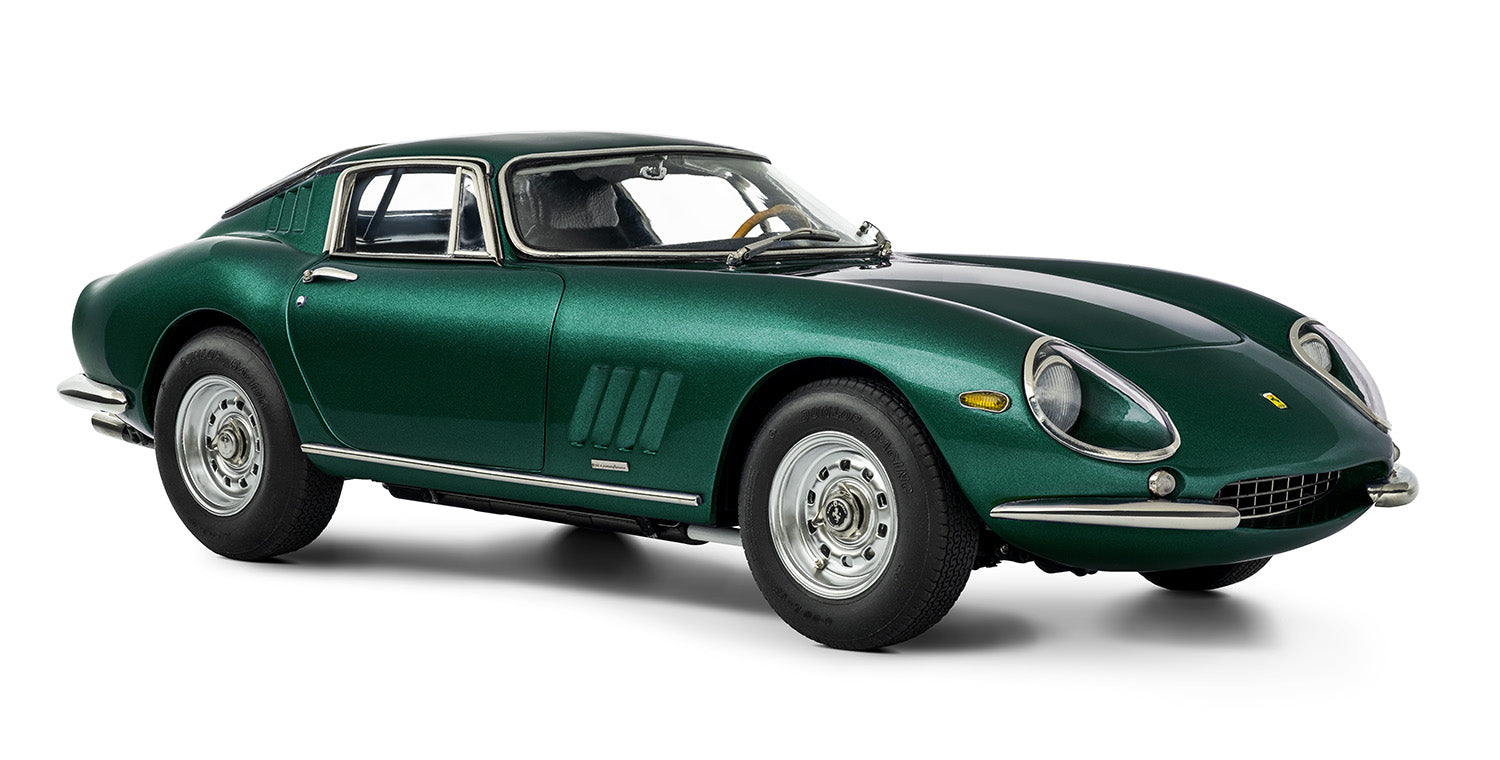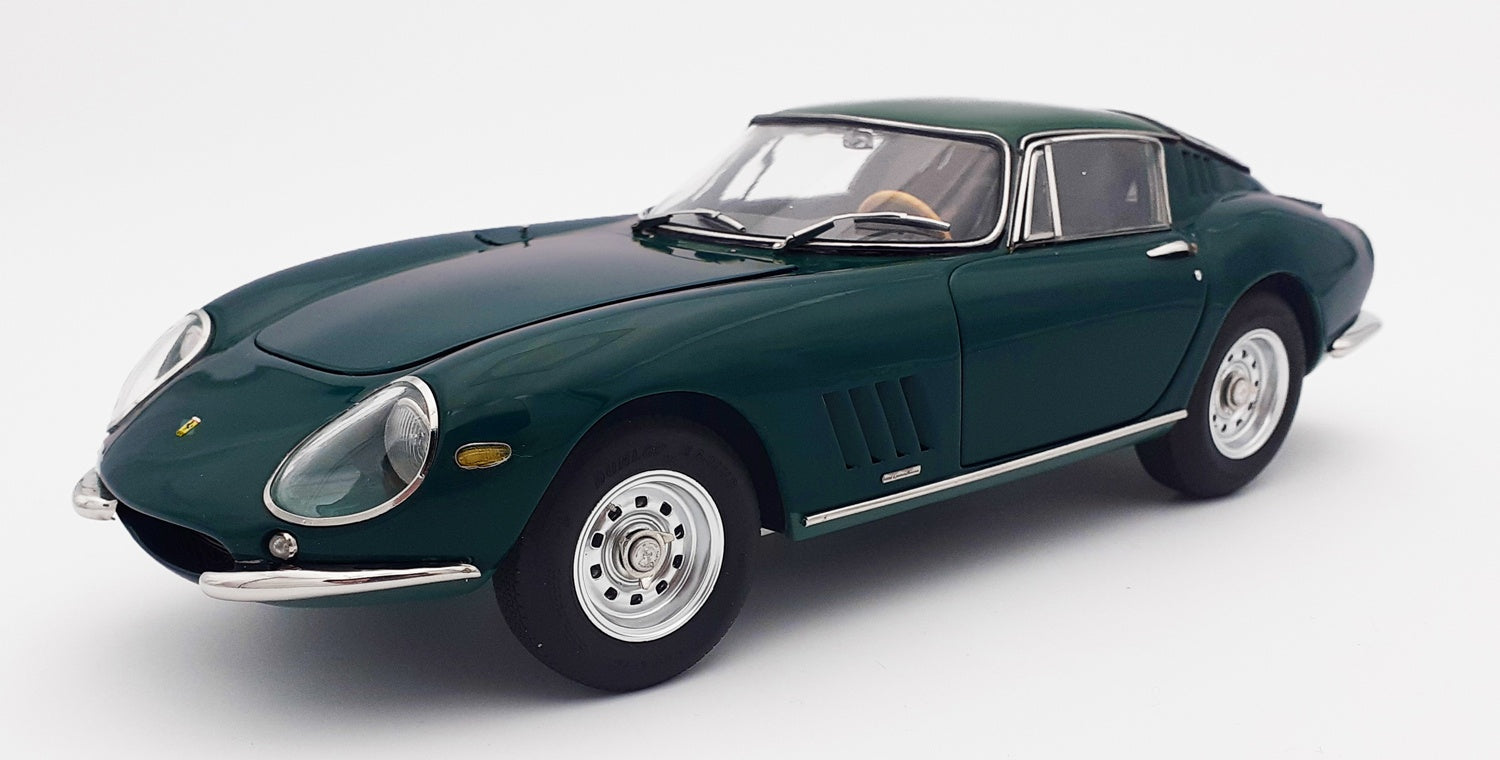

Ferrari 275 GTB/C Verde Pino CMC M-238 LE 1,000 pieces

Description
In 1966, Ferrari launched the 275 GTB/C on a completely new chassis developed by Mauro Foghieri for both a race and road car. Designated the Tipo 590A, the chassis was lighter and stronger than the standard version. A total of twelve 275 GTB/C Scaglietti Berlinetta Competizione were built by Ferrari's racing department in Maranello, featuring the relatively opulent bodywork typical of Pininfarina designs of the era.
To accommodate the necessary clearance for the racing tires (7" x 15" front and 7.5" x 15" rear), the wheel arches are flared, making the GTB/C's body wider than a standard production GTB, especially at the rear, where the fenders behind the doors are wider. The body is also clad in a 0.028-inch (0.7112 mm) thick aluminum skin, half the thickness of a standard-body GTB.
Eight of the twelve GTB/Cs built were left-hand drive, and two of these, the vehicles with chassis numbers 9067 and 9085, were equipped with alloy wheels and Pirelli tires like our M-210. For the first time, Ferrari used a needle-bearing transaxle (the transmission is integral with the rear axle). Instead of a cooling fan, the natural air intake, combined with a water and oil cooler, provided the necessary cooling performance, even under endurance racing conditions.
A dry-sump lubrication system allows the engine to be positioned lower and further forward to improve weight distribution. A 3,286 cc Tipo 213 Competition V-12 engine with three Weber 40 DF13 carburetors produces 280 hp at 7,700 rpm. Many engine parts are cast from Elektron, a magnesium alloy, to reduce weight.
The interior of the 275 GTB/C features rear-end bracing to prevent the body from flexing in an impact. With an impressive racing record spanning decades, the 275 GTB/C will be fondly remembered as one of Ferrari's last true racing and road-going sports cars. For many Ferrari enthusiasts, the 275 GTB/C is in no way inferior to the GTO, which famously became a sought-after investment.
Notice
In 1966, Ferrari launched the 275 GTB/C on a completely new chassis developed by Mauro Foghieri for both a race and road car. Designated the Tipo 590A, the chassis was lighter and stronger than the standard version. A total of twelve 275 GTB/C Scaglietti Berlinetta Competizione were built by Ferrari's racing department in Maranello, featuring the relatively opulent bodywork typical of Pininfarina designs of the era.
To accommodate the necessary clearance for the racing tires (7" x 15" front and 7.5" x 15" rear), the wheel arches are flared, making the GTB/C's body wider than a standard production GTB, especially at the rear, where the fenders behind the doors are wider. The body is also clad in a 0.028-inch (0.7112 mm) thick aluminum skin, half the thickness of a standard-body GTB.
Eight of the twelve GTB/Cs built were left-hand drive, and two of these, the vehicles with chassis numbers 9067 and 9085, were equipped with alloy wheels and Pirelli tires like our M-210. For the first time, Ferrari used a needle-bearing transaxle (the transmission is integral with the rear axle). Instead of a cooling fan, the natural air intake, combined with a water and oil cooler, provided the necessary cooling performance, even under endurance racing conditions.
A dry-sump lubrication system allows the engine to be positioned lower and further forward to improve weight distribution. A 3,286 cc Tipo 213 Competition V-12 engine with three Weber 40 DF13 carburetors produces 280 hp at 7,700 rpm. Many engine parts are cast from Elektron, a magnesium alloy, to reduce weight.
The interior of the 275 GTB/C features rear-end bracing to prevent the body from flexing in an impact. With an impressive racing record spanning decades, the 275 GTB/C will be fondly remembered as one of Ferrari's last true racing and road-going sports cars. For many Ferrari enthusiasts, the 275 GTB/C is in no way inferior to the GTO, which famously became a sought-after investment.











